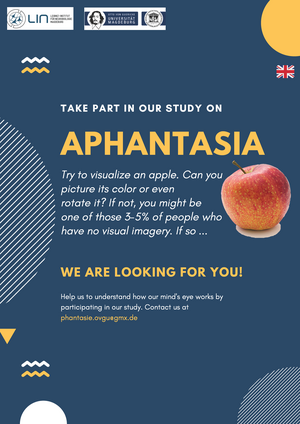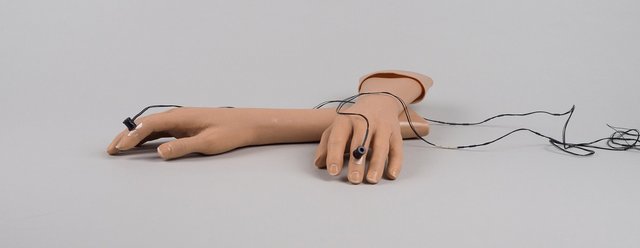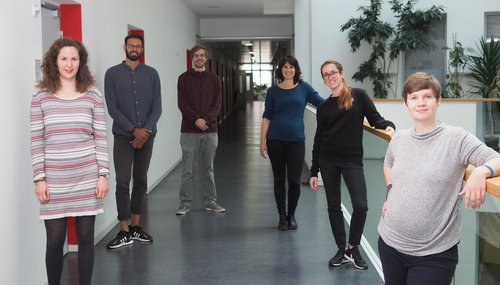Somatosensory and Body Perception
We study psychological and brain mechanisms related to the way we experience touch and the space that surround us, and how this interaction is used to construct representations of our body and to guide our actions. In addition, we are interested in discovering the full potential of aphantasic and hyperphantasic individuals to understand the role that visual imagery, and the lack of it, has in the way sensory events are perceived, and the way memories are encoded and retrieved.
We combine a wide range of methods from psychology and cognitive neuroscience, including psychophysics, classification of hand kinematics, electro- and magnetoencephalography (EEG, MEG) in healthy adults, children, and patients with neurological dysfunction (e.g., neglect, Amyotrophic lateral sclerosis).
One of the goals of the group is to provide new insights into the understanding of tactile awareness to develop clinically relevant concepts for the formation of therapies in the recovery of tactile and proprioceptive function after brain injury.
- Head
Head

Elena Azañón studied Psychology at the University of Barcelona, and received her doctorate in 2011 in Experimental Psychology, from the same University. On 2012, she was granted with a Marie Curie Fellowship to work at the Institute of Cognitive Neuroscience in London (University College London). After completing her first postdoctoral position, she continued her scientific work at Birkbeck, University of London, where she worked as a senior postdoc until she was appointed the Dorothea Erxleben Visiting Professorship at the Otto-von-Guericke University Magdeburg for the years 2018/2019. Since June 2020, she leads a Junior Research Group on somatosensory and body perception at the Department of Behavioral Neurology at the Leibniz Institute for Neurobiology.
- Members
Members
Head Dr. Elena Azanon +49-391-6263-92301 elena.azanon@ovgu.de PhD students Anwesha Das anwesha.das@med.ovgu.de Alexandros Karagiorgis alexandros.karagiorgis@med.ovgu.de Lisa Klemm +49-391-6263-92331 lisa.klemm@med.ovgu.de Katarzyna Myga +49-391-6263-92521 katarzyna.myga@ovgu.de Avinash Kalyani avinash.kalyani123@gmail.com Students Anna Felsberg anna.felsberg@gmail.com Benjamin Hoffmann benjamin.hoffmann@st.ovgu.de Varg Koenigsmark varg.koenigsmark@ovgu.de Celine Jackel celine.jakel@st.ovgu.de Cheye Bollmann cheyebollmann@gmail.com Fatima Idrees fatima.idrees@ovgu.de Alumni Anastasia Chrysidou anastasia.chrysidou@ovgu.de - Projects
Projects
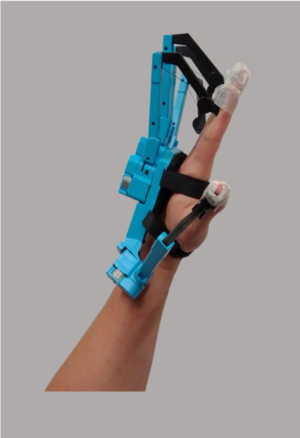
Hand kinematics 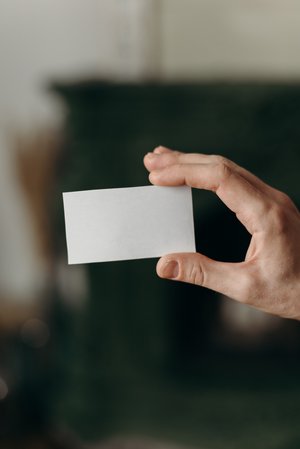
Spatial categorization (Photo by cottonbro from Pexels) 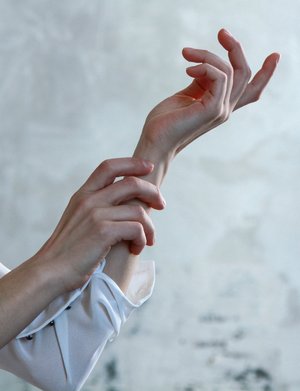
Tactile Perception (Photo by Tatiana from Pexels) Tactile remapping and adaptation
Part of our research focuses on how we experience touch. In particular, it focuses on the complex multisensory mechanisms that allow us to extract spatial information from touch using information about posture, and explains how this is used to construct representations of our body and to guide our actions.
Tactile Remapping: Similar to the remapping of retinotopic coordinates of visual input, necessary to maintain visual stability across eye movements, touch also needs to be remapped as we move, i.e., from skin-based (e.g., a tickle on the right arm) to visual space (e.g., a tickle on the right arm which is currently raised above the head). Our work has provided the first empirical demonstration of this remapping from skin-based to visual space (Azañón & Soto-Faraco, 2008, Current Biology), its temporal course (Azañón et al., 2010, European Journal of Neuroscience; Overvliet et al., 2011; Soto-Faraco & Azañón, 2013, Neuropsychologia; Azañón et al., 2016, Current Biology), and the first causal evidence of its neuroanatomical locus (Azañón et al., 2010, Current Biology). Part of our research has also focused on the development of this process of tactile remapping in healthy individuals, infants and children born with congenital cataracts (Azañón & Soto-Faraco, 2007, Experimental Brain Research; Azañón et al., 2018, Child Development).
Tactile adaptation: Adaptation aftereffects have been extensively used, because they provide insight about how different dimensions of stimuli are selectively processed by populations of neurons. In a recent study, we demonstrated that the distance between two distinct tactile events is a property of somatosensation susceptible to adaptation. Moreover, the reported aftereffects shared several characteristics with low-level visual aftereffects, including orientation and location specificity, in favor of the idea that computation of tactile distances arises at early stages of somatosensory processing (Calzolari et al., 2017, Proceedings of the National Academy of Science; Hidaka et al., 2020, Acta Psychologica).
Interaction between body representation and touch
In the last years, we have focused in the understanding of higher levels of cognition, regarding touch (Azañón et al., 2016, Cognition; Azañón et al., 2016, Journal of Experimental Psychology: HPP), and body representation (Azañón et al., 2016 Multisensory Research, Tame & Azañón et al., 2019, Frontiers in Psychology). For instance, we are currently investigating the role that vision of the body has in the perception of our body image (in collaboration with Prof. Dr. Matthew Longo, Birkbeck University London). In particular, the effect of the thin body ideal in our body perception (e.g., through visual images and haptically, through the manipulation of dolls), which is shaped and reinforced by many social influences (Ambroziak et al., 2019, Frontiers in Psychology).
Spatial categorization and prior information
It is assumed that people’s reports from memory are reconstructions, influenced by Bayesian priors derived from past experience (Tame & Azañón et al., 2019, Frontiers in Psychology, Romano et al., 2019, Journal of Experimental Psychology: HPP). We have developed novel methods to depict the internal structure of localization biases from memory both for visual and tactile localization (Azañón et al., 2020, Cognition). Understanding this Bayesian combination of current source with prior information, as well as whether specific locations of visual space (or the skin), might have a special status in spatial cognition, is one of the current lines of research in our lab (in collaboration with Prof. Dr. Matthew Long, Birkbeck University London, and Dr Raffaele Tucciarelli, University College London).
Top-down regulation and perception
Empirical evidence on how far and to what extent top-down regulation can alter one’s own neurophysiological bodily states, is so far scarce. If bodily sensations, such as touch or pain can be altered by visual imagery or autosuggestion, i.e., by one’s own will, this can benefit the formation of future therapies in the recovery of sensory function after brain injury, for instance, after stroke. In a recent project (Bial Foundation), we use a combination of psychophysical modelling techniques and electrophysiological recordings together with state-of-the-art neuroimaging technology (7T fMRI, in collaboration with Dr. Esther Kühn, DZNE Magdeburg), to answer the question of how top down control, through autosuggestion and visual imagery, influences one’s own neurophysiological bodily states, in particular with regard to tactile and pain perception.
PhD student: Katarzyna Myga
Disease diagnosis in daily life from wearable kinematics
Clinicians suffer from the limited meaningfulness of patient data acquired in clinical settings. Not only is the number of available tests limited, the acquired data are also influenced by motivational, emotional, and subjective factors, such as doctor-patient relationships or a physician’s experience. In addition, quantitative data on the patients’ real-life behavior in a familiar environment are usually not available. In a project funded by the Center for Behavioral Brain Sciences (CBBS) we use recent advances in basic research on the tracking and classification of hand movements to develop a novel medical product (the Diagnostic Glove) that helps clinicians to diagnose, track, and classify sensorimotor disorders of the upper limbs (in collaboration with Dr. Esther Kühn, Dr.Christoph Reichert and Prof. Dr. Stefanie Schreiber).
PhD students: Lisa Klemm, Avinash kalyani
Visual imagery spectrum: from aphantasia to hyperphantasia
Mental imagery is the ability to create representations of places, things and people in the mind. Imagery can comprise information from any source of sensory input, such as tactile, auditory or gustatory. Despite the capacity of imaging in the mind’s eye was believed to be inherent to all women and men, recently the term aphantasia has been coined to describe those individuals who cannot visualize imagery voluntarily. On the other hand, a group of people describe themselves as having extraordinarily rich mental visualization, almost as in actual vision. This capacity has been termed hyperphantasia. We are interested in discovering the full potential of aphantasic and hyperphantasic individuals, and understand the role that visual imagery, and the lack of it, has in the way sensory events are perceived, and the way memories are encoded and organized.
- Selected Publications
Selected Publications
Azañón E, Tucciarelli R, Siromahov M, Amoruso E, Longo MR (2020). Mapping visual spatial prototypes: Multiple reference frames shape visual memory. Cognition 198, 104199
Azañón, E., Camacho, K., Morales, M., & Longo, M. R. (2018). The sensitive period for tactile remapping does not include early infancy. Child Development, 89, 1394-1404.
*Calzolari, E., *Azañón, E., Danvers, M., Vallar, G., & Longo, M. R. (2017). Adaptation aftereffects reveal that tactile distance is a basic somatosensory feature. Proceedings of the National Academy of Sciences, 114, 4555-4560
Azañón, E., Mihaljevic, K., & Longo, M. R. (2016). A three-dimensional spatial characterization of the crossed-hands deficit. Cognition, 157, 289-295.
Azañón, E., Stenner, M. P., Cardini, F., & Haggard, P. (2015). Dynamic tuning of tactile localization to body posture. Current Biology, 25, 512–517.
Azañón, E., Longo, M. R., Soto-Faraco, S., & Haggard, P. (2010). The posterior parietal cortex remaps touch into external space. Current Biology, 20, 1304-1309.
Azañón, E., & Soto-Faraco, S. (2008). Changing reference frames during the encoding of tactile events. Current Biology, 18, 1044-1049.A list of all the publications can be found here
- Current Third Party Funds
Current Third Party Funds
2021-2024
DFG grant (SFB 1436)
„Neural Resources of Cognition“
2019-2022
Center for Behavioral Brain Sciences, Germany
Neuronetwork, Disease Diagnosis in daily life from wearable kinematics.
http://www.cbbs.eu/en/research-funding/neuronetworks/nn162019-2020
Experimental Psychology Society, UK
EPS Small Grant, Prototype Effects in Memory for Spatial Locations2019-2022
BIAL foundation, Portugal
Grants for Scientific Research, Altering cutaneous sensations with autosuggestion. - Teaching & Internships
Teaching & Internships
Elena Azañón teaches students at the OVGU in the M.Sc. in Psychology
We welcome applications from students interested in a Bachelor’s, Masters’ or doctoral thesis or to complete an internship in the Group. We are looking for motivated students from the subjects of psychology, neuroscience, engineering, medicine and computer science. Basic knowledge of a programming language (Matlab, Python etc.) is desired but not required.
- News, Participants and Job opportunities
News, Participants and Job opportunities
We are currently offering several position:
